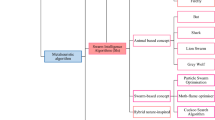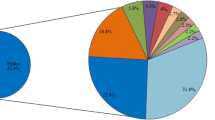Abstract
Parallel hydropower systems encounter a high risk of spillage in flood periods. Therefore, controlling spillage should be considered when hydropower systems increase power generation and satisfy power grid demand. To meet multiple operation targets, an effective operation method needs to precisely control the reservoir level and quickly adjust the power schedule based on real-time load changes. In this paper, an optimal operation method for parallel hydropower systems combining reservoir level control and power distribution is proposed. The method generates reservoir level control rules using a multi-objective simulation method for no gird demands operation. It obtains a power distribution schedule considering spill risk and non-storage losses for gird demands. Taking a parallel system in southwest China as an example, the results show that the method can produce an annual power generation of 55.2 billion kWh, which is a 6.1% improvement compared to regular method. Moreover, it can precisely control the daily water level and quickly adjust power distribution. It can be applied to parallel systems and has favorable results in power generation, peak shaving, and especially spillage reduction.





Similar content being viewed by others
Data Availability
Some data, models, or code generated or used during the study are available from the corresponding author by request.
References
Ahmadianfar I, Kheyrandish A, Jamei M, Gharabaghi B (2020) Optimizing operating rules for multi-reservoir hydropower generation systems: an adaptive hybrid differential evolution algorithm. Renew Energ 167:774–790. https://doi.org/10.1016/j.renene.2020.11.152
Barros M, Tsai F, Yang S, Lopes J, Yeh W (2003) Optimization of large-scale hydropower system operations. J Water Resour Plan Manag 129(3):178–188. https://doi.org/10.1061/(ASCE)0733-9496(2003)129:3(178)
Chang L, Chang F (2009) Multi-objective evolutionary algorithm for operating parallel reservoir system. J Hydrol 377(1–2):12–20. https://doi.org/10.1016/j.jhydrol.2009.07.061
Cheng C, Shen J, Wu X, Chau K (2012) Operation challenges for fast-growing China’s hydropower systems and respondence to energy saving and emission reduction. Renew Sustain Energy Rev 16(5):2386–2393. https://doi.org/10.1016/j.rser.2012.01.056
Feng Z, Niu W, Cheng C (2019) China’s large-scale hydropower system:Operation characteristics, modeling challenge and dimensionality reduction possibilities. Renew Energ 136:805–818. https://doi.org/10.1016/j.renene.2019.01.059
Guo Y, Chen W, Chen S (2008) Use of fuzzy preference matrix for multi-objective fuzzy optimization decision-making model. In 2008 7th World Congress on Intelligent Control and Automation (pp. 7108–7112). IEEE. https://doi.org/10.1109/WCICA.2008.4594577
He Z, Zhou J, Qin H, Jia B, He F, Liu G, Feng K (2020) A fast water level optimal control method based on two stage analysis for long term power generation scheduling of hydropower station. Energy 210:118531. https://doi.org/10.1016/j.energy.2020.118531
Hui R, Lund J (2015) Flood storage allocation rules for parallel reservoirs. J Water Resour Plan Manag 141(5):04014075. https://doi.org/10.1061/(ASCE)WR.1943-5452.0000469
Ji C, Zhou T, Huang H (2014) Operating rules derivation of Jinsha Reservoirs system with parameter calibrated support vector regression. Water Resour Manage 28(9):2435–2451. https://doi.org/10.1007/s11269-014-0610-6
Jiang Z, Ji C, Qin H, Feng Z (2018) Multi-stage progressive optimality algorithm and its application in energy storage operation chart optimization of cascade reservoirs. Energy 148:309–323. https://doi.org/10.1016/j.energy.2018.01.176
Labadie J (2004) Optimal operation of multireservoir systems: State-of-the-art review. J Water Resour Plan Manag 130(2):93–111. https://doi.org/10.1061/(ASCE)0733-9496(2004)130:2(93)
Liu S, Xie Y, Fang H et al (2020) Impacts of inflow variations on the long term operation of a multi-hydropower-reservoir system and a strategy for determining the adaptable operation rule. Water Resour Manage 34:1649–1671. https://doi.org/10.1007/s11269-020-02515-6
Lund J (2000) Derived power production and energy drawdown rules for reservoirs. J Water Resour Plan Manag 126(2):108–111. https://doi.org/10.1061/(ASCE)0733-9496(2000)126:2(108)
Lund J, Guzman J (1999) Derived operating rules for reservoirs in series or in parallel. J Water Resour Plan Manag 125(3):143–153. https://doi.org/10.1061/(ASCE)0733-9496(1999)125:3(143)
Moraga R, García-González J, Nogales S, Arteseros M (2006) A contingency analysis for managing the risk of water spillage and shortage in a mid-term hydro scheduling model. In 2006 International Conference on Probabilistic Methods Applied to Power Systems (pp. 1–6). IEEE. https://doi.org/10.1109/PMAPS.2006.360201
Ramaswamy V, Saleh F (2020) Ensemble based forecasting and optimization framework to optimize releases from water supply reservoirs for flood control. Water Resour Manage 34:989–1004. https://doi.org/10.1007/s11269-019-02481-8
Turgeon A (2007) Stochastic optimization of multireservoir operation: The optimal reservoir trajectory approach. Water Resour Res 43(5). https://doi.org/10.1029/2005WR004619
Vedula S, Mujumdar P, Sekhar G (2005) Conjunctive use modeling for multicrop irrigation. Agric Water Manag 73(3):193–221. https://doi.org/10.1016/j.agwat.2004.10.014
Wang J (2010) A new stochastic control approach to multireservoir operation problems with uncertain forecasts. Water Resour Res 46(2). https://doi.org/10.1029/2008WR007217
Wang J, Cheng C, Wu X, Shen J, Cao R (2019) Optimal hedging for hydropower operation and end-of-year carryover storage values. J Water Resour Plan Manag 145(4):04019003. https://doi.org/10.1061/(ASCE)WR.1943-5452.0001046
Wang L, Sun P, Jiang Z, Wang B, Zhang Y (2015) Study on cascade energy storage operation chart optimization of Li Xianjiang basin based on progressive optimal algorithm. In Advanced Materials Research (Vol. 1073–1076, pp. 1641–1650). Trans Tech Publications, Ltd. https://doi.org/10.4028/www.scientific.net/amr.1073-1076.1641
Wong T (2015) Performance evaluation of classification algorithms by k-fold and leave-one-out cross validation. Pattern Recogn 48:2839–2846. https://doi.org/10.1016/j.patcog.2015.03.009
Wu X, Cheng C, Zeng Y, Lund J (2016) Centralized versus distributed cooperative operating rules for multiple cascaded hydropower reservoirs. J Water Resour Plan Manag 142(11):05016008. https://doi.org/10.1061/(ASCE)WR.1943-5452.0000685
Xu B, Zhong P, Lu Q, Zhu F, Huang X, Ma Y, Fu J (2020) Multiobjective stochastic programming with recourses for real-time flood water conservation of a multireservoir system under uncertain forecasts. J Hydrol 590:125513. https://doi.org/10.1016/j.jhydrol.2020.125513
Zeng X, Hu T, Cai X, Zhou Y, Wang X (2019) Improved dynamic programming for parallel reservoir system operation optimization. Adv Water Resour 131:103373. https://doi.org/10.1016/j.advwatres.2019.07.003
Zeng X, Hu T, Xiong L, Cao Z, Xu C (2015) Derivation of operation rules for reservoirs in parallel with joint water demand. Water Resour Res 51(12):9539–9563. https://doi.org/10.1002/2015WR017250
Zhang L, Kang C, Wu C, Yu H, Jin J, Zhou Y, Zhou T (2022) Optimization of drought limited water level and operation benefit analysis of large reservoir. Water Resour Manage 36:4677–4696. https://doi.org/10.1007/s11269-022-03271-5
Zhang X, Liu P, Xu C, Guo S, Gong Y, Li H (2019) Derivation of hydropower rules for multireservoir systems and its application for optimal reservoir storage allocation. J Water Resour Plan Manag 145(5):04019010. https://doi.org/10.1061/(ASCE)WR.1943-5452.0001056
Zhou Y, Guo S (2013) Incorporating ecological requirement into multipurpose reservoir operating rule curves for adaptation to climate change. J Hydrol 498:153–164. https://doi.org/10.1016/j.jhydrol.2013.06.028
Zhou Y, Guo S, Liu P, Xu C, Zhao X (2016) Derivation of water and power operating rules for multi-reservoirs. Hydrol Sci J 61(2):359–370. https://doi.org/10.1080/02626667.2015.1035656
Zhu Y, Zhou J, Zhang Y, Jiang Z, Jia B, Fang W (2022) Optimal energy storage operation chart and output distribution of cascade reservoirs based on operating rules derivation. Water Resour Manage 36:5751–5766. https://doi.org/10.1007/s11269-022-03333-8
Acknowledgements
The research work described in this paper is supported by the National Natural Science Foundation of China (52179005 and 91647113). The authors gratefully acknowledge senior engineer Liu Yan of State Grid Chongqing Electric Company, who suggest modifications and improvement suggestions to the work described in this paper.
Funding
The research work described in this paper is supported by the National Nature Science Foundation of China (52179005 and 91647113).
Author information
Authors and Affiliations
Contributions
All authors contributed to the study conception and design. Xinyu Wu and Chuntian Cheng provided the idea of the model construction. Xinyu Wu and Yuan Lei collected study data and analyzed model performance results. The first draft of the manuscript was written by Yuan Lei and revised by Qilin Ying. All authors read and approved the final manuscript.
Corresponding author
Ethics declarations
Ethical Approval
Not applicable.
Consent to Participate
Not applicable.
Consent to Publish
Not applicable.
Competing Interests
The authors have no relevant financial or non-financial interests to disclose.
Additional information
Publisher's Note
Springer Nature remains neutral with regard to jurisdictional claims in published maps and institutional affiliations.
Rights and permissions
Springer Nature or its licensor (e.g. a society or other partner) holds exclusive rights to this article under a publishing agreement with the author(s) or other rightsholder(s); author self-archiving of the accepted manuscript version of this article is solely governed by the terms of such publishing agreement and applicable law.
About this article
Cite this article
Wu, X., Lei, Y., Cheng, C. et al. An Optimal Operation Method for Parallel Hydropower Systems Combining Reservoir Level Control and Power Distribution. Water Resour Manage 37, 1729–1745 (2023). https://doi.org/10.1007/s11269-023-03451-x
Received:
Accepted:
Published:
Issue Date:
DOI: https://doi.org/10.1007/s11269-023-03451-x




